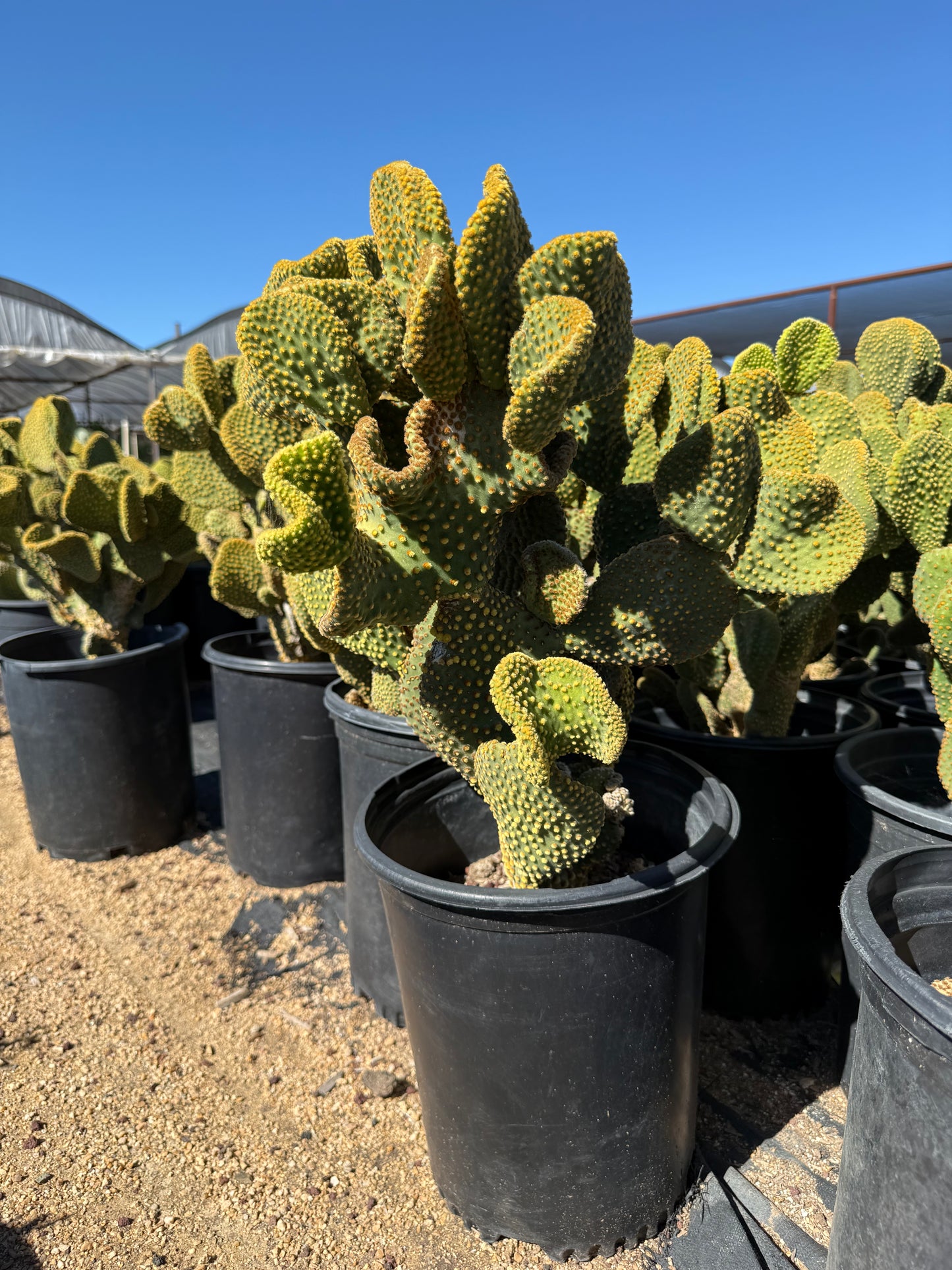My Store
Crested Microdasys
Crested Microdasys
Couldn't load pickup availability
Plant Type: perennial, crested (monstrose) form of prickly pear cactus
Plant Height: 1–2 feet (can reach 3 feet in maturity)
Spread: 2–4 feet
Flower Color: bright yellow
Sun Exposure: Full sun
Crested Microdasys / Opuntia microdasys monstrosus: A Sculptural Desert Rarity of Living Geometry
Opuntia microdasys monstrosus, commonly known as the Crested Microdasys or Monstrose Bunny Ear Cactus, is a rare and mesmerizing mutation of the beloved Opuntia microdasys species. This extraordinary cactus displays undulating, fan-shaped growth patterns that resemble desert coral or living sculpture. Its textured pads twist and curl in unpredictable forms, creating an organic masterpiece that looks like something carved by the wind and sun themselves.
Native to northern Mexico, this crested form thrives under the same tough conditions as its parent species—full sun, heat, and arid soil—making it one of the most intriguing yet low-maintenance collector cacti for Arizona gardens.
Key Features of Opuntia microdasys monstrosus
The Crested Microdasys grows in dense, compact clumps of fan-like pads that fold and ripple into architectural shapes. Each “crest” varies, sometimes forming tight ruffles and other times sprawling into wide, wave-like surfaces. The pads are typically blue-green to olive-green, covered in small clusters of fine yellow or white glochids that appear soft but can detach easily if touched.
Though it rarely grows tall, its unusual form makes it visually commanding—like a miniature desert landscape frozen in motion. In spring through early summer, mature specimens occasionally produce bright yellow blooms along their ridges, contrasting dramatically with the plant’s sculptural structure.
Because no two specimens crest the same way, each plant is a one-of-a-kind natural artwork, prized by collectors and designers for its organic beauty and meditative asymmetry.
Growing and Care Tips
Opuntia microdasys monstrosus thrives in full sun and sharply draining soil, performing best on slopes, berms, or in elevated planters where water never pools. In the Phoenix Valley, it loves intense sunlight and reflected heat, and its compact form makes it resistant to wind and weather stress.
Water deeply but infrequently during the first few months after planting—typically every 14–21 days depending on temperature and drainage. Once established, water only every 4–6 weeks in summer and rarely in winter. Overwatering or poor drainage is the most common cause of decline.
It is cold hardy to around 20°F, though covering during frost helps protect its intricate form. Pruning is generally unnecessary; simply remove any damaged or misshapen sections if desired. Handle with care, as glochids are fine and easily dislodged.
For containers, use a wide, shallow pot with a gritty cactus mix and a decomposed granite top dressing to emphasize its sculptural lines.
Landscaping Uses
The Crested Microdasys is ideal as a focal-point specimen in rock gardens, raised planters, and modern desert landscapes. Its unique form adds artistic movement and texture where traditional cacti provide rigidity. It’s especially striking when backlit by morning or evening light, which highlights its rippling contours and the fine glow of its glochids.
Pair it with smooth-textured companions like Blue Glow Agave, Toothless Desert Spoon (Dasylirion longissimum), or Golden Barrel Cactus for contrast. In contemporary gardens, it works beautifully among boulders or near pathways where its one-of-a-kind structure can be appreciated up close.
This plant also excels in container gardens on patios or entryways—perfect for collectors or homeowners seeking a conversation piece that captures desert artistry in living form.
Summary
The Crested Microdasys (Opuntia microdasys monstrosus) is one of the desert’s most fascinating natural sculptures. With its undulating, fan-like pads, glowing glochids, and mesmerizing form, it transforms any Arizona landscape into an art piece. Tough, slow-growing, and exceptionally low-maintenance, this cactus brings timeless beauty and intrigue—proving that even the harshest environments can produce the most elegant creations.
Three Timbers Installation Guide (Feel Free to Follow):
Opuntia microdasys monstrosus Planting Guide:
Location: Full sun; select an open, bright area with at least 8 hours of direct sunlight daily. Handles reflected heat and rocky terrain exceptionally well.
Soil: Use a sharply draining cactus mix blended with decomposed granite, sand, or pumice. Avoid compact or moisture-retentive soils.
Spacing: Allow 3–4 feet between plants or structures to accommodate mature spread and airflow.
Planting Depth: Keep the base level with or slightly above soil grade. Avoid burying pad joints or over-mounding.
Support: None required; once established, the plant stabilizes naturally under its own dense growth form.
Watering Guide:
Watering After Planting: Water deeply once after planting to settle the soil. Then allow it to dry completely before watering again. During the first 3–4 months, water every 14–21 days depending on temperature and drainage.
When is the Plant Established? The Crested Microdasys is considered established after 6–9 months, when new growth forms along the fan edges and the plant maintains steady color.
Watering Once Established: Water every 4–6 weeks during summer if no rainfall occurs. In winter, water only during extended drought.
Drip Irrigation Setup: Install one low-flow emitter (0.5–1 gallon per hour) about 8–10 inches from the base, angled outward. Run sparingly and ensure complete drying between cycles.
General Watering Tips: Always confirm soil dryness before watering. Overwatering leads to rot or structural collapse. A top dressing of decomposed granite or gravel enhances appearance, prevents splashing, and emphasizes the plant’s sculptural beauty. Keep material several inches from the base for airflow and long-term health.
Share














